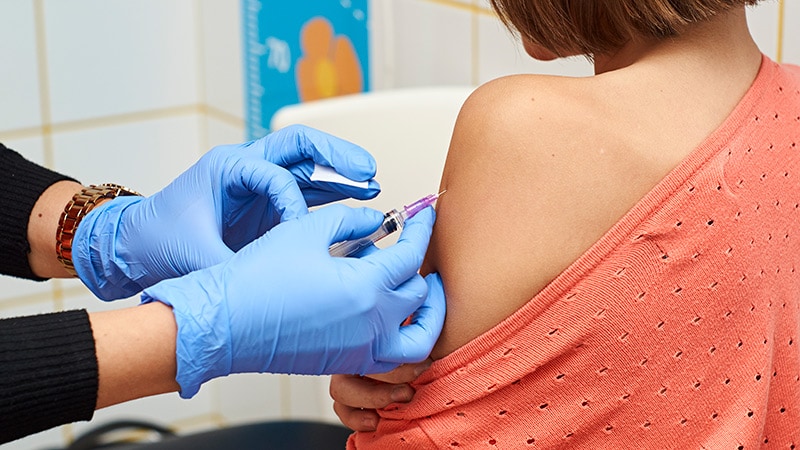Vaccines against human papillomavirus (HPV) have been hailed as a success: they have been shown to decrease the incidence of cervical lesions associated with the HPV types that are in the vaccine.
However, new evidence suggests that HPV vaccination makes women more susceptible than their nonvaccinated peers to HPV genotypes not covered by the vaccine.
An expert not involved in the research said the new data “tell us to be a little bit careful.” Although the HPV types not included in the vaccine are rarer and less agresssive, they can still cause cancer.
The data come from the Costa Rica HPV Vaccine Trial, which involved more than 10,000 women aged 18–25 years. The HPV vaccine used in the trial was Cervarix, from GlaxoSmith Kline. It covers the two leading causes of cervical cancer, HPV 16 and 18, and provides partial protection against three other genotypes.
After a follow-up of 11 years, among vaccinated women, there was an excess of precancerous cervical lesions caused by genotypes not included in the vaccine, resulting in negative vaccine efficacy for those HPV variants.
The increase wasn’t enough to offset the overall benefit of vaccination when all genotypes were considered, say the researchers, led by Jaimie Shing, PhD, a postdoctoral research fellow at the National Cancer Institute in Bethesda, Maryland.
Vaccinated women “still had long-term absolute reductions in high-grade lesions,” they point out.
The net protection “remained considerable, emphasizing the importance of HPV vaccination for cervical cancer prevention,” the team concludes.
The findings were published online on June 13 in The Lancet Oncology.
The results are likely the first evidence to date of “clinical unmasking” with HPV vaccination, meaning that protection against the strains covered by the vaccine leaves women more prone to attack from other carcinogenic HPV variants.
This phenomenon “could attenuate long-term reductions in high-grade disease following successful implementation of HPV vaccination programmes,” the investigators comment.
Highlighting a Need for Caution
The take-home message from the trial is that “we have to be careful,” said Marc Steben, MD, co-president of HPV Global Action and a professor in the University of Montreal’s School of Public Health.
He noted that the Cervarix HPV vaccine used in the trial is not the vaccine that is used now in developed nations.
The current standard HPV vaccine is Gardasil 9 (Merck & Co), which offers broader coverage against nine HPV types (types 6, 11, 16, 18, 31, 33, 45, 52, and 58).
There are 12 main carcinogenic HPV genotypes, so unmasking of other strains is still possible with Gardasil 9, he said.
There is another issue, Steben added. The success of HPV vaccinations ― a nearly 90% reduction in invasive cervical cancer in women who are vaccinated at a young age ― has led to questions about the future role of routine cervical cancer screening.
“Some people are saying that if we achieve 90% coverage, we might” eliminate community transmission and no longer need to screen, he said.
These trial results “tell us to be a little bit careful,” Steben continued. Those HPV types that are less aggressive and rarer than HPV 16 and 18 “can still cause cancer and might be there and surprise us. It could take more time than we thought” to get to the point where screening can be eliminated.
“There might be a little problem if we stop too early,” he said.
Study Details
During the period 2004–2005, investigators randomly assigned 3727 women aged 18–-25 years to receive Cervarix and 3739 to a control group that received the hepatitis A vaccine; after 4 years, the control group also received Cervarix and exited the study. They were replaced by an unvaccinated control group of 2836 women. The new control group and the original HPV vaccine group were followed for an additional 7 years.
In years 7–11 of the trial, the investigators found 9.2 additional cervical intraepithelial neoplasias of grade 2 or worse (CIN2+) from HPV types not covered by Cervarix per 1000 vaccinated women in comparison with unvaccinated participants. This corresponds to -71.2% negative vaccine efficacy against CIN2+ lesions of HPV types not covered by the vaccine.
There were 8.3 additional CIN3+ lesions from nontargeted HPV strains per 1000 vaccinated women in comparison with unvaccinated participants, which corresponds to -135% negative vaccine efficacy.
Overall, however, there was a net benefit of vaccination, with 27 fewer CIN2+ lesions when all HPV genotypes ― vaccine covered or not ― were considered per 1000 vaccinated women over the entire 11 years of follow-up.
There were also 8.7 fewer CIN3+ lesions across all genotypes per 1000 vaccinated women, but the benefit was not statistically significant.
Among the study limits, the team was unable to evaluate the effect of clinical unmasking on cervical cancer, because women were treated for high-grade cervical lesions before cases could progress to cervical cancer.
The trial was funded by the National Cancer Institute and the NIH Office of Research on Women’s Health. GlaxoSmithKline provided the Cervarix vaccine and supported aspects of the trial. Two authors are named inventors on US government–owned HPV vaccine patents with expired licenses to GlaxoSmithKline and Merck. Steben is an advisor/speaker for many companies, including GlaxoSmithKline and Merck & Co.
Lancet Oncol. Published June 13, 2022. Abstract
M. Alexander Otto is a physician assistant with a master’s degree in medical science and a journalism degree from Newhouse. He is an award-winning medical journalist who worked for several major news outlets before joining Medscape and is also an MIT Knight Science Journalism fellow. Email: aotto@mdedge.com
For more news, follow Medscape on Facebook, Twitter, Instagram, and YouTube.
